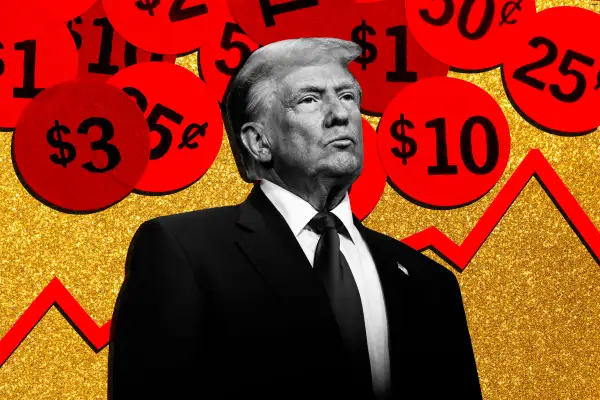How Do Republican Presidents Affect the Price of Gold?
Money is not a client of any investment adviser featured on this page. The information provided on this page is for educational purposes only and is not intended as investment advice. Money does not offer advisory services.

For thousands of years, gold has been an integral part of societies as both a status symbol and a medium of exchange. The precious metal continues to attract many investors to this day.
Elections — especially presidential elections — have commonly played a role in gold prices given how each of America’s major political party’s policies influence asset classes of all types.
Former President Trump is attempting to return to the White House, and voters will decide that in the coming days. However, gold investors should consider how another Trump presidency would affect their holdings.
How gold performed during Trump's first presidency
It’s rare for a former president to run again following an election loss. Trump hopes to join Grover Cleveland as the only other former president who regained the White House following defeat in the previous election.
In January 2017 when Trump assumed office, gold was trading for $1,572.40 per troy ounce. Gold initially had a good start during his term, but the precious metal shed its gains by mid-2018. Then, gold rallied in 2019, continuing its strong gains the following year with the arrival of the COVID-19 pandemic.
By the time President Biden took office in January 2021, gold was priced at $2,228.89 per troy ounce after having gained 42% during Trump’s administration. That represents an annualized 8.1% gain, which matches the historical mean of gold’s annual returns from 1960 to the present.
Arguably, Trump’s most impactful policy for gold prices was the Tax Cuts and Jobs Act (TCJA). This law reduced the corporate tax rate, offered higher standard deductions and made other sweeping changes to the U.S. tax code.
Most importantly, the TCJA injected money into the economy, contributing to inflation. Gold tends to perform better during economic cycles with high inflation. This dynamic is also the reason why gold delivered a 25.75% return in 2020 — Trump’s last year in office. That year, the Federal Reserve’s monetary policies sent gold prices soaring along with almost every other asset class.
How other Republican presidents have impacted gold prices
The three Republican presidents who preceded Trump were George W. Bush, George H.W. Bush and Ronald Reagan. Gold performed well under the younger Bush, with the precious metal logging multiple years of +20% gains. The precious metal didn’t have a down year once in his back-to-back administrations and logged a 31.59% gain in 2007.
Gold didn’t fare as well under his father’s term, though. From 1989-1993, gold only had one year of positive returns under the Bush Sr. administration. The precious metal logged a 17.64% return in 1993, with low to mid-single-digit declines in the other years despite recession and the Gulf War — two factors that historically bode well for gold prices.
Gold also performed poorly under Reagan, starting with a 32.76% decline during his first year in office in 1981. Then, the yellow metal experienced multiple years of double-digit declines during the remainder of Reagan’s terms, with a 24.46% gain in 1987 as one of the few bright spots.
Timing played a role in the total returns of gold generated during each of those Republican presidencies. George W. Bush enjoyed an economic boom during his first term, while interest rates spiked during Reagan’s presidency in an effort to combat elevated inflation. High interest rates are unfavorable to gold due to their deflationary nature, and rates reached 18.4% in October 1981.
What affects gold prices
Inflation, interest rates and geopolitical uncertainty are major drivers of the price of gold. The precious metal tends to gain value during low interest rate environments and periods of high inflation, while usually losing value during economic cycles with interest rate hikes and low inflation.
Any uncertainties in the economy or global politics can also increase the price of gold. Investors view gold as an inflation hedge and safe haven for their wealth. While central banks can print more of their currency, they don’t have the same luxury with gold, which gives it the perception of being a store of value subject to lower volatility.
That distinction allows gold to retain more of its value in the long run compared to fiat currencies like the U.S. dollar. Gold’s ability to retain value better than fiat currencies is one of the main reasons it attracts so-called gold bugs. Furthermore, gold has been used for thousands of years, making it older than any fiat currency.
How a potential 2025 Trump presidency could affect gold prices
Gold has moderate tailwinds for either candidate heading into 2025. Interest rates should remain steady or continue to decrease, while inflation only inched up by 2.4% year-over-year in September 2024.
While gold prices had a slow start during Trump’s first four years in the Oval Office, the asset could generate respectable returns if he returns to the White House. The former president is likely to maintain a firm stance on further interest rate reductions — whether or not that is capable of persuading the Fed — just as he did during his first term.
The Republican candidate has also proposed the idea of ending federal income taxes. Many investments, including gold, would likely rally if this were to become a reality since this policy would increase consumer spending. The likelihood of that aim is debatable, though, but even a reduction in income taxes could continue gold’s present rally.
